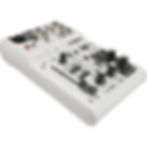Connecting Your Microphone to Your PC: Mixer or Audio Interface?
- Luis Vigil
- Jan 22, 2021
- 4 min read
Updated: Sep 15

Investing in the right microphone is one of the biggest, and sometimes most important, upgrades you can make to your content creation setup. However, you’ll need a proper mixer or audio interface to power many of these microphones, so let’s figure out which one is right for you!
Mixers

A mixer is a device that helps you adjust and route incoming and outgoing audio signals and can generally take in a variety of analog audio inputs such as XLR, RCA, ¼ inch and 3.5 mm. Some mixers also manage digital audio from USB, which means you can sometimes mix in your computer’s audio and send that back to your PC with the analog inputs audio as well.
Mixers are generally preferred when you need to constantly manage the audio levels from a variety of sources, such as your microphone, audio from your gaming PC, audio from a console and perhaps even audio from sources like musical devices or connected phones. Generally, if you’re going to be managing content for an event you’ll need an audio mixer for all potential inputs, not to mention the sound from a live audience. This also applies to a live stream from your home for whatever kind of content you are doing that requires multiple input sources.
One key feature you’ll need to look out for, regarding your microphone, is phantom power as if you have a condenser microphone this is a required feature, so finding a mixer that can provide that phantom power is vital!

Another thing to consider is electrical noise. Unless a master electrician blessed your space you’re likely to have issues with grounding and electrical noise, especially when you plug in things like consoles and PCs into your mixer. You’ll hear the very distinctive hum of electrical noise, this is also common if you need to connect your mixer into the line in port on your PC. The best way to resolve this issue is to buy ground loop isolators. Basically, you plug your source into your ground loop isolator before plugging it into your mixer. The same then applies to your output if you’re not connecting via USB, plug it into the isolator then into the PC.
The final point is the size of the mixer you might need. Mixers can range from tiny to the size of an entire room and really you will need one that has as many ports as sources you intend to plug into it. For most content creation, a small compact mixer with USB functionality is ideal but for someone broadcasting music, live production or an event, you will need to start scaling up. Do, however, keep in mind the space you’re going to be putting this mixer in. The more inputs, the more of your desk it’s going to take up!
Audio Interfaces

Audio interfaces are a type of mixer, but a type with a more specific purpose. Generally, interfaces have a limited amount of inputs and these inputs tend to be specifically meant for microphones such as an XLR or ¼ inch inputs. Usually, these run off USB power and normally require a type of special driver get installed on your computer. Interfaces that have more than one input tend to also come with mixing software with many of the same routing and adjustment options that larger mixers have as physical interfaces. This usually means that audio interfaces offer the highest quality audio recording capabilities with high sample rates and bit depth.
Sample rate, briefly, is basically the resolution at which your audio is captured, higher sample rates mean clean audio, as long as you have your levels adjusted correctly. Bit depth is the dynamic range of your audio recording. This is basically how loud your incoming signal can be. Now, most recording software will have an upper limit of 24 bits, but some interfaces are capable of 32 bits, which means you can recover audio that might have otherwise been missed.

Virtually all audio interfaces will include phantom power inputs, but it’s also helpful to check if additional features are included for microphones. These could include things like limiters, which help prevent incoming audio from clipping or have special features that can add filters or sound signatures to your microphone that can emulate more expensive microphone pre-amps. A lot of these features can also be included in the software that comes with the audio interface.
One of the biggest features audio interfaces have over a mixer is size! You can find yourself tiny one input interfaces that will fit perfectly on a desk!
So which do you choose?
As you might be figuring out, honestly it depends on what needs you have. Are you going to be running a live event, live stream or broadcasting some music? Do you have multiple sources you need to control the volume of on the fly? A mixer is the thing you’re looking for, just make sure you have the space for it! If you need high-quality audio coming in from a microphone that you can just set and forget, an audio interface is the best choice. Also, if you’re looking to have a portable setup for recording or streaming an audio interface is ideal!
Whichever device you end up using, they’re easy to use with XSplit products! If you’re connecting via USB or Line input, you can set these devices as your microphone input in XSplit Broadcaster and have everything go out to your stream or into your recorded content exactly the way you want it to sound. XSplit Broadcaster also has advanced audio features that may be missing depending on what kind of device you go for with various DSP effects available.



